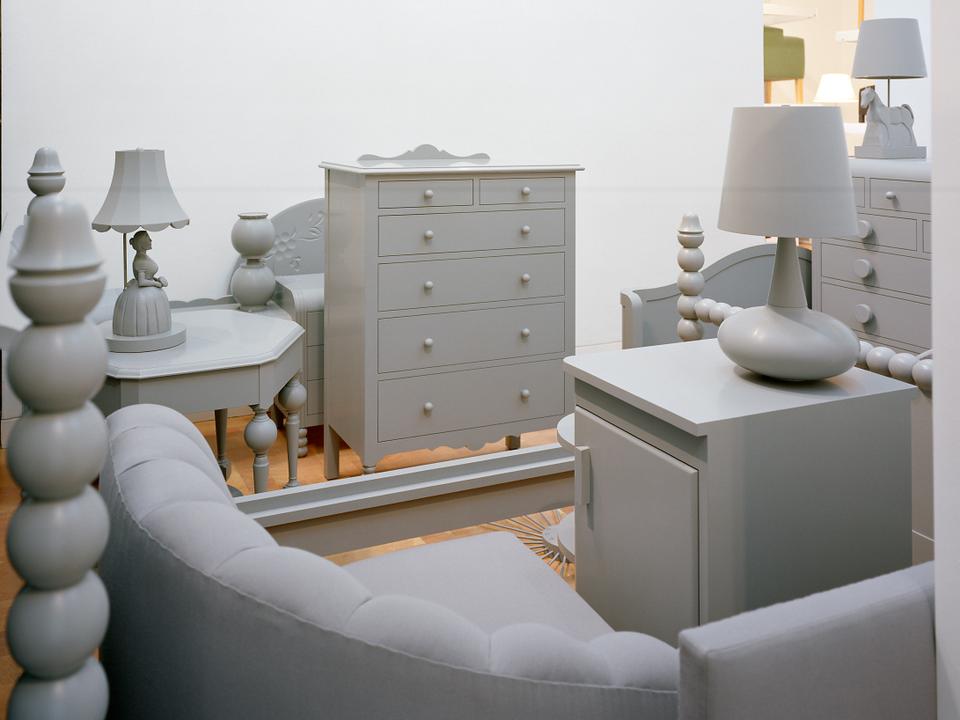
News
Harvard Alumni Email Forwarding Services to Remain Unchanged Despite Student Protest

News
Democracy Center to Close, Leaving Progressive Cambridge Groups Scrambling

News
Harvard Student Government Approves PSC Petition for Referendum on Israel Divestment

News
Cambridge City Manager Yi-An Huang ’05 Elected Co-Chair of Metropolitan Mayors Coalition

News
Cambridge Residents Slam Council Proposal to Delay Bike Lane Construction
Clashing Tones Confuse “Color” at ICA

Immediately upon entering the Institute of Contemporary Art’s new exhibit, “Figuring Color: Kathy Butterly, Felix Gonzalez-Torres, Roy McMakin, Sue Williams,” a visitor encounters a strange assortment of artworks: biomorphic ceramic sculptures, violent depictions of exploding bodies, a gigantic bead curtain, and chairs.
The selection seems eclectic, to say the least, but there is something that unifies the four artists in the exhibition—they all use color in a way that evokes the human body. This, in a nutshell, is the premise of the exhibition, which runs until May 20. The four artists are a diverse bunch—Williams is a painter, Butterly is a sculptor, the late Gonzalez-Torres worked with installations, and McMakin is a sort of postmodern carpenter—and their use of color is not quite enough to unite their unique styles into a cohesive show. Indeed, though the individual works are distinctive and thought-provoking, the connections between them seem contrived rather than coincidental, and these forced categorizations distract from the pieces’ other themes.
Given the diversity of works, curator Jenelle Porter wisely divided the rooms based on subject matter to give the pieces in each room greater cohesion The show is grouped into four rooms: “Surface,” “Insides,” “Memory,” and “Joy.” Only the “memory” room successfully unites dissimilar works around a common use of color; the other three rooms’ intriguing individual pieces are thematically disjointed.
Though the “Memory” room only features two artworks—McMakin’s 2003 “Lequita Faye Melvin” and Feliz Gonzalez-Torres’s 1991 “Untitled (Lover Boys)”—it manages, more than any other room, to emphasize how the artists use color to evoke similar themes. Gonzalez-Torres’s piece, made up of 355 pounds of blue and white candy, is a tribute to his partner, who died of AIDS. McMakin’s piece, though less funereal, is explicitly concerned with remembrance. The work, a monochrome reproduction of all of the furniture he recalls from his childhood homes, is a strikingly literal representation of the weight of memory. Both works use a severely limited palette to create a somber mood, though there are nuances—while Gonzalez-Torres memorializes a specific loss, McMakin uses his muted grays to make a melancholy statement about the passage of time itself. The uniformly gray household items, oddly clustered in the middle of the vast gallery, feel both surreal and poignant.
This room is the high-water mark of the show. Nowhere else is there such graceful interplay between the works. The “Joy” room, though supposedly thematically unified, is problematic: The pieces share exuberant, bright colors, but the messages of the works are divergent. Though Williams’ vibrant canvases don’t clash visually with the blue mirror that is Gonzalez-Torres’s 1991 “Untitled (Fear),” they also don’t engage with the darker undercurrents in the latter work. The room ignores the deeper themes of these works in its effort to classify them by color.
More troubling are the rooms that do not group works by emotions. In the “Insides” room, for instance, Williams’ paintings are paired uncomfortably with another installation by Gonzalez-Torres—a gigantic bead curtain called “Untitled (Blood).” Though Gonzalez-Torres’ work superficially connects with Williams’ paintings, which depict explosions filled with body parts, Williams’ pieces take a more inflammatory tone. Gonzalez-Torres’s work is a somber piece about those killed by AIDS. Williams’ works, with names like “American Enterprise” and “Record Profits,” advance explicitly polemical messages, given punch by her use of uniformly applied colors against a white background, which recalls the clear contours of Roy Lichtenstein. Because they do not work together on a thematic level, the works must compete for the audience’s attention. Though Williams’s paintings are large, they seem much smaller compared to the truly massive “Untitled (Blood),” which diminishes their visceral impact.
A similar imbalance occurs in the “Surface” room, which is devoted to works by McMakin and ceramic artist Butterly. McMakin’s furniture here is more subtle than his “Lequita Faye Melvin” and is thus overshadowed by Butterly’s bizarre ceramic pieces. Though tiny, these works are notable for their sexual frankness; one piece, entitled “Just for Men,” resembles a vagina complete with pubic hair. A slide on the wall identifies both works as being concerned with sensuality; while this is evident in Butterly’s work, it is much more subdued in McMakin’s two items. McMakin’s subtlety is not a failing, nor are Butterly’s sculptures are too forthright, but by juxtaposing them, the exhibit leads viewers to overlook McMakin’s quieter statements.
This combination—like so many of the matchups in “Figuring Color”—is misjudged and plays to neither of the works’ strengths. Gonzalez-Torres, Butterly, McMakin, and Williams all use color in intriguing ways, but four such diverse artists do not a movement make, and while this exhibit’s concept is interesting, its forced execution seems detrimental to the artists’ powerful works.
—Staff writer Petey E. Menz can be reached at menz@college.harvard.edu.
Want to keep up with breaking news? Subscribe to our email newsletter.
